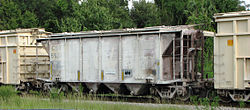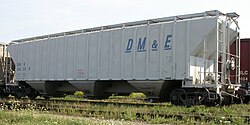AY Honors/Model Railroad/Answer Key


A covered hopper is a railroad freight car. Structurally, it is very similar to an open-top hopper car in that the carbody consists of a large hopper with unloading chutes at the bottom. What distinguishes this type of car from an open hopper is not only the car's roof, but also the car's overall size. Covered hoppers typically carry loads of less dense, and therefore lighter, materials, so they are built to a higher cubic capacity than open top hoppers. They are used predominantly to haul various grains such as corn, wheat and barley.
Some covered hoppers are built to carry loads that are heavy, but very susceptible to damage if exposed to the weather. Loads such as cement, processed phosphate, and kaolin clay are carried, in powdered form, in covered hoppers. Covered hoppers designed for these loads more closely resemble open-top hoppers.
Covered hoppers in North American service have been built by most of the freight car manufacturers of the 20th century. The most common covered hoppers that are still in use were built by either Pullman-Standard or ACF.
Here's some more informtion on covered hoppers: 1)TYPES/History: in the beginning of north americian railroading, damagable bulk loads where an issue for the railways. Wheras a load of pots could go into a boxcar, a keg of nails could go into a gondala or a boxcar, a load of grain or cement really had no car to move in. Double sheathed boxcars (two walls, one on top of the other) where used to protect these loads from weather. The problem was simply unloading time-workers had to enter the car, and manually clean it out. As wages increased, so did problems. Parallel to this, coal was becoming a large money maker for the railways. This cargo, orginally moved in gondalas' also needed to be unloaded by hand. To allow for fast unloading, s required by power plants, the pennsylvania railroad, in conjection with pullman standard, built the first open hopper. The bottom unloading of course made unloading much easier. Now, back to cement. As this was becoming a large revenue source, pullman built a small steel hopper car with a roof. This car, the first PS-2 covered hopper, started the covered hopper family. The 1750 cu ft cement hopper car is the direct decendent of this first car. However, grain remained a boxcar load. By the late 1950's those boxcars had worn out. Long, heavy, diesel powered freights became common. Newer, heavier rail was laid. Grain became a centralized commonity. Pullman-standard once again took the lead, and released the 4425 cu ft grain covered hopper. This car revalotionized grain handling by allowing for quick, easy loading(troughs in the roof), and unloading( hatches in the floor) apart from that, it looked like a standard straight waller hopper car. In the 1970's, the gaint 4750 cu ft covered hopper was released. These are still in service today. Versions have been built by PS, Evans rail products, PC&F, and Canada car. Another type of covered hopper is the ACF(americian car and foundry) center flow. This is now the most common covered hopper in service. Its' main advantage is the ease of unloading, especially for granular products(Salt, soda ash, chemicals). You see, the PS car has a large steel shaft that runs from one set of wheels through the bottom of the car to the other set-this creates a strong car, but provides a surface that can hang up cargo. Free flowing cargo, like grain or soybeans, isn't really caught, but those granular loads will. The ACF solution is to build the car bottom as a grid, with strong steel shafts on the sides of the car, with cross members running across the car. So there is no hang up space and loads flow freely. The most common size is 4650 cu ft, but other sizes have been built. A third type is from Canada. This one is the Cylindrical covered hopper. It looks like a beer can lying flat on its' side, on wheels. This type was designed by the Canadian wheat board, and built by several canadian companies. It holds 4550 cu ft. However, by moving the hopper ends farther apart, car up to 4750 cu ft have been built. Powdered products: even with covered hoppers powdered goods( think flour, powdered sugar) remained hard to transport. The reason is that the loads stick toghether, and don't unload. A first solution, for GATX, was the AIRSIDE covered hopper. In this car, Large air bags are mounted inside the car, on the walls. at unloading time, an air hose is connected to those bags. By inflating and deflating them, the powdered load is unloaded. Pressuraide cars are more modern. in these cars, Pipes are used to connect are the unloading hatches. Compressed air is used from the top of the car to force the load out. Some plants use a vacuum on the unloading pipe to suck load out, thus speeding up the process. Plastic pellets: recently massive 6000 cu ft cars have been built for moving plastic pellets. Common loads in these car types are4500 cu ft+ plain covered hoppers: Chemicals,salt,feed/seed, grain,soybeans, corn, and any light to medium weight bulk load. 2000 cu ft cars: Cement, soda sh, or any dense, heavy bulk load. Airside or pressuraide: flour, powdered sugar, or any powdered load.
